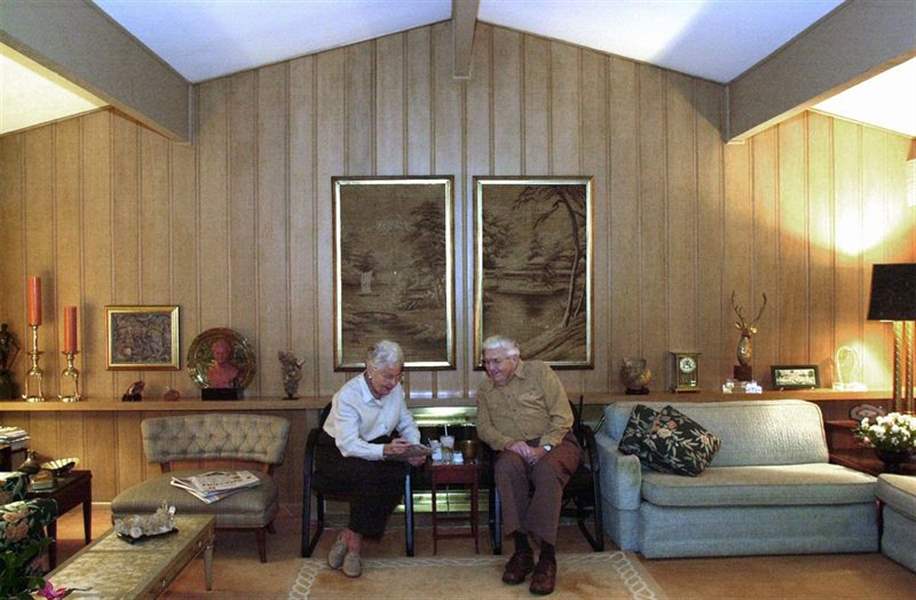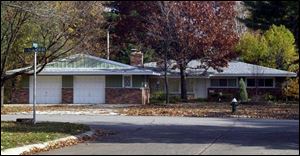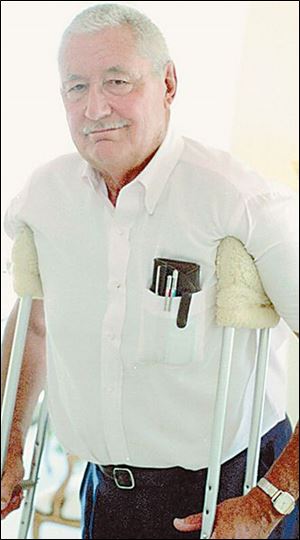
Toledo's Don Scholz made California contemporary part of the Midwest's vernacular
11/16/2002
Posy and Robert Huebner's house in Toledo's Lincolnshire features a typical vaulted, beamed ceiling.
blade

Low, sweeping lines and liberal use of glass characterize the houses that Donald Scholz designed and prefabricated for the Lincolnshire neighborhood in Toledo, among other areas.
Long before the move to Arizona, before the massive bankruptcy filing, before the sale of his Toledo company to Inland Steel Co. for $90 million, Donald J. Scholz had an idea in the early 1950s.
It was to take the open ranch-style homes then popular in California, adapt them for Toledoans hungry for something other than the small boxes that went up after World War II, and prefabricate them to lower the production costs.
The result was a style he used throughout the Lincolnshire neighborhood of west Toledo as well as in Imperial Woods and in several subdivisions in the suburbs of Toledo and Cleveland, and which he sold to at least 75 builders in other cities.
The innovations of the late Mr. Scholz in the early 1950s were in part responsible for several salutes by the national building industry. He was named two years ago by Builder magazine as one of the 20th century's 100 most influential figures in residential building.

Models of California ranch houses adapted for the Midwest by Don Scholz are on view at the library.
The California contemporary designs also are the basis of a retrospective at the Main Toledo-Lucas County Library at 325 Michigan St. “Designing the '50s: The Scholz Influence” is free and open to the public through Nov. 26.
“He was an innovator, because he actually was able to customize the housing for people at a reasonable cost,” said Ramon Alvarez, a Cleveland State University student whose research led to the library exhibit.
“The postwar subdivisions had small lots and the homes were very compact. Mr. Scholz decided to change that, by using larger lots with wider houses.”
Mr. Scholz, who walked with crutches because of a bout with polio, was an engineer by training, a background that played into the design and construction of his homes.
A sales brochure for Lincolnshire said the homes, sized at 1,050 to 1,250 square feet, ranged in price from $15,950 to $18,950. They were manufactured at a cost of $9 a square foot.
“Our prices are made possible because these are probably the most thoroughly engineered houses ever built,” said the brochure. “Eight months of continuous work went into the plans. Every board, nail, and piece of pipe was completely detailed. Every operation has been analyzed for the development of labor-saving techniques.”
The Toledo builder and developer adapted the designs for the local weather, using insulated glass for the floor-to-ceiling windows and creating an indoor foyer garden that allowed homeowners to bring the outdoors inside.

Posy and Robert Huebner's house in Toledo's Lincolnshire features a typical vaulted, beamed ceiling.
But it was the bathroom ceiling that caused Posy Huebner to fall in love with a Scholz-designed home in the 1950s.
“It was fun back then to go through these new houses,” she said. “The bathroom ceiling just wowed me. It was a ceiling that had lights all over it. It was the most wonderful thing.”
Mrs. Huebner and her husband, Robert, so loved the three-bedroom house on Stanhope Drive in Lincolnshire that they bought it in January, 1957. Several additions later, they're still there.
“We have loved this house,” she said. “It has never become dated as far as we're concerned. There's a lot of glass in this house and there're cathedral ceilings in the living room and the master bedroom. Plus, we really appreciate more than ever that it's all on one floor.”
A native of the Cleveland area, Mr. Scholz estimated that he designed and built 50,000 homes throughout the country during his long career. In 1969, he was named builder of the year by Professional Builder magazine for being a pioneer in modular housing and for being among the first to sell land and building projects. He was inducted into the National Association of Home Builders Hall of Fame in 1979.
Part of his genius was at marketing - developing packages bought by builders across the country. Included were the structure design, plus standard sets of furnishings and appliances.
“He was very much of an innovator in terms of housing production and housing costs, while having distinct designs,” said Daryl Blanchard, a retired Toledo architect.
Mr. Blanchard remembered that as a seventh grader in 1947 accompanying his parents on drives to look for new homes he was hit by the freshness of Mr. Scholz's designs.
“Not only were we shopping, but the rest of Toledo was shopping,” he said. “After the war years, when we had to put up with old things, we all wanted something new.”
Mr. Scholz's “design signature” of vaulted ceilings and beams appealed to many people, Mr. Blanchard said.
“Scholz not only had new housing but you always got what you paid for,” the Toledo architect said. “If it was an expensive home, there were a lot of innovations. There were also inexpensive homes, but they were always ones that were of very good style and high quality.”
Mr. Alvarez, who plans to become an architect, said part of Mr. Scholz's success with his first company was recognizing trends.
“He recognized after the 1950s that the American public was not prepared to stick with a contemporary skyline, so he converted [designs] into more American traditional housing,” he said. “The homes he designed later were two-story, brick, with not as much glass.”
Mr. Scholz started Scholz Homes, Inc., in 1946. It was a publicly held housing manufacturing firm that he sold more than two decades later to Inland Steel for $90 million. But rather than rest on his laurels, Mr. Scholz became a land developer and launched another company - Donald J. Scholz & Co. - with plans for 17 major projects in such far-flung cities as Los Angeles, San Francisco, Atlanta, Chicago, and Washington.
But it was the era when environmentalists and anti-urban-sprawl activists were gaining power, and his projects stalled all over the country.
A large part of his undoing proved to be a planned $400 million project called River Bluffs at Fallen Timbers in Monclova Township, which was prime farmland in the early 1970s that many people didn't want developed.
Faced with staggering debt, Mr. Scholz filed for bankruptcy in 1976, listing debts totaling $57 million and assets of just $160,000.
Fifteen years after the bankruptcy filing and his departure from the Toledo area, Mr. Scholz was very vocal about who he thought was to blame for the death of the Monclova project.
“Marcy Kaptur took it on herself to stir up the farmers in Monclova,” he said to a Blade reporter in 1990 of the Toledo area's veteran U.S. representative. “She stirred it up to the point where I couldn't get it zoned. That killed the project.”
But Mr. Scholz reincarnated himself for a third time, launching a successful career as a developer of luxury homes in the Phoenix area, where he died in September, 1999, at the age of 80. He left behind his wife, Gerri; daughter, Michelle, and sons, John, who still runs the design firm they started together, and Tom, a founder of the rock group Boston.
Duane Ankney, developer of Waterside in Monclova Township, said his development and that of the site for the proposed Mall at Fallen Timbers, sit on the land where Mr. Scholz dreamed big. Ironically, he said, current development is unfolding in a very similar way to the proposal by the longtime developer.
“I've seen his original plans, and Don Scholz was very much a visionary,” Mr. Ankney said. “He was way ahead of his time.”
“Designing the '50s: The Scholz Influence” opened last month and will be at the main library through Nov. 26. Original blueprints, photographs, and models of Scholz homes are accented by furniture, publications, and other memorabilia associated with the 1950s. The exhibit is free and open to the public. The second part of a lecture series put on by Ramon Alvarez, a student of the contributions of Mr. Scholz, will be held at 6:30 p.m. tomorrow in the McMaster Family Center for Lifelong Learning at the main library. It is open to the public.